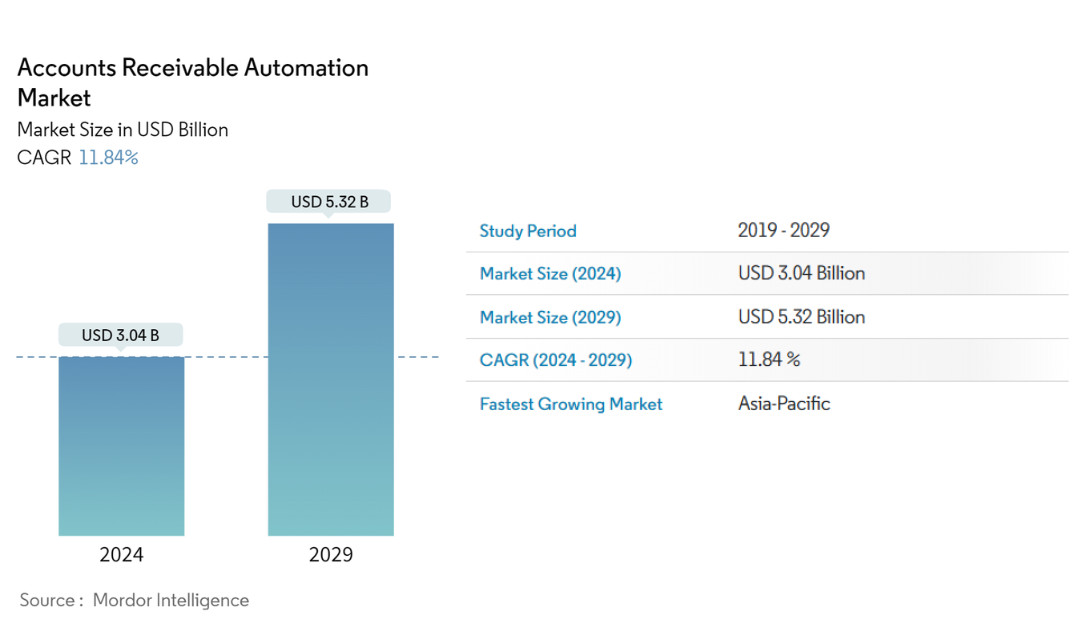Technological advancements are often not given their due recognition. However, it is important to be aware of the recent trends in account receivables if you want to gain a competitive edge in the business environment. 2024 was about technological advancements and setting trends from using artificial intelligence to integrating real-time payments are continuously transforming how businesses manage their AR processes.
Looking at statistical accounts receivables trends, an industry report by the Mordor Intelligence marked the accounts receivables automation market size at USD 3.04 bn in 2024, growing at a 11.84% CAGR and reaching USD 5.32 bn by 2029. It further delved on how the automation software market is experiencing a steep growth curve due to the need for greater business efficiency, optimised cash flow and cost savings. The accounts receivables trends data further indicates that businesses that used AR automation softwares witnesses improved processing times and higher productivity across the teams.
Moreover, 65% of the businesses that participated in the survey confirmed recouping the software investment in accounts receivables automation within the first year, whereas a total of 78% regained the investment cost post 18 months.

In this blog, we’ll get into the details of the top 5 accounts receivable trends for 2025 and in the years to come that every business should know to enhance efficiency and improve their cash flow.
Table of Contents
1. Smart AR: Leveraging AI for Superior Management
Artificial Intelligence (AI) is transforming Accounts Receivable management and making it simpler by automating routine tasks, forecasting payment behaviors, and identifying potential issues before they escalate. AI algorithms can analyze vast amounts of data to offer insights. By implementing AI in AR management, businesses can reduce the time spent on manual processes, minimize errors, and enhance decision-making capabilities.
2. Forecast the Future: Predictive Analytics in AR
Predictive analytics is another game-changer in the realm of Accounts Receivable. By evaluating historical data and current trends, predictive analytics can predict future payment patterns and trends. This approach allows businesses to anticipate potential cash flow issues and take protective actions to mitigate them.
It also plays a major role in enabling companies to capitalize their invoice management processes, ensuring that invoices are sent at the most opportune times to encourage prompt payment. This trend not only improves the accuracy of cash flow forecasting but also enhances the efficiency of receivables automation, leading to a more streamlined AR process.
3. Seamless Integration: Uniting ERPs with AR
Integrating Enterprise Resource Planning (ERP) systems with Accounts Receivable processes is becoming increasingly crucial for businesses looking to streamline operations. This seamless integration ensures that all financial data is centralized, reducing the risk of errors and improving the accuracy of financial reporting.
By uniting ERPs with AR, businesses can automate many aspects of their AR processes, from invoice generation to payment reconciliation. This not only saves time but also minimizes human error, leading to more accurate and timely financial data. Additionally, integrated systems provide real-time visibility into AR metrics, enabling businesses to make informed decisions quickly and efficiently.
4. Instant Gratification With Real-Time Payments
The demand for real-time payments is expanding, and organizations are progressively using this payment trend to improve their accounts receivable procedures. Real-time payments have various advantages, including increased cash flow, faster payment processing, and higher customer satisfaction.

Real-time payments features lets firms receive funds immediately, also enabling better cash flow management. This development is also consistent with the increased popularity of contactless transactions, which provide customers a more seamless and fast payment experience. We see that as more companies accept real-time payments, AR procedures will become faster and more efficient.
5. Customer First: Elevating the Payment Experience
Today, when customers and clients have one-click access to never ending options, offering a superior customer experience is important more than ever. This is especially true in the field of accounts receivable, where the payment experience has a considerable impact on customer happiness and loyalty.
Businesses are increasingly focusing on improving the client payment experience by providing various payment trends, clear information, and easy-to-use payment gateways. Businesses that prioritise the customer experience and use AI technology can encourage timely payments and lower the risk of conflicts.

Conclusion
Looking at 2025 and months lying ahead, the way businesses manage Accounts Receivable is set to change in meaningful manners. Trends like AI integration, predictive analytics, real-time payments, and a stronger focus on the customer experience are driving smarter and more efficient approaches to AR management.
Adapting to these tech advancements now is key to staying ahead of the competition in your sector or industry, and ensuring sustained success. The future of accounts receivable holds tremendous potential, and businesses that take action today will be the ones that excel. With Febi.ai, you can simplify your AR processes with features like invoice creation, debtors aging reports and debtors summary reports–all accessible on a real-time basis.
Ready to see how Febi.ai can transform your AR management? Experience the difference firsthand.










